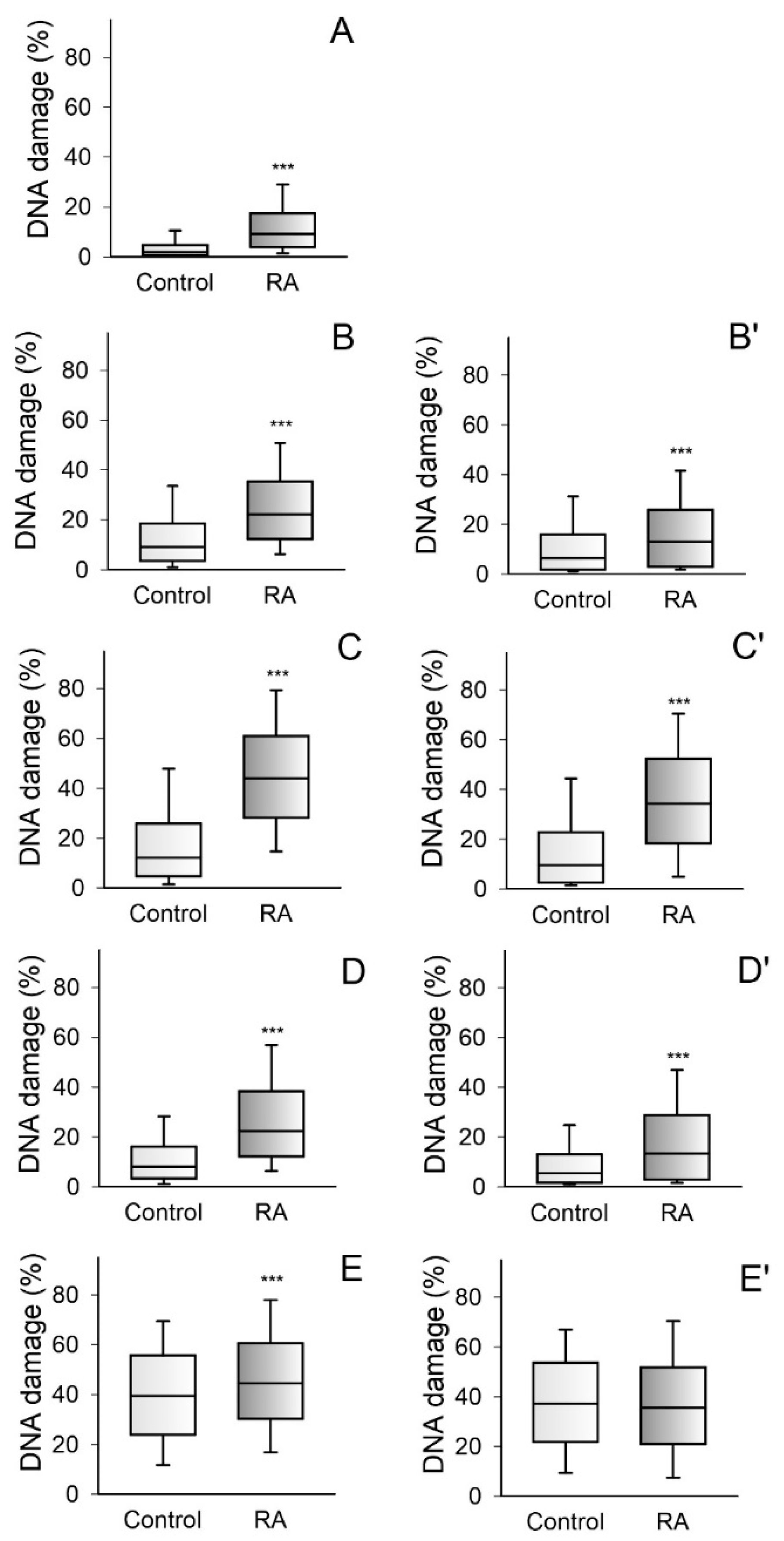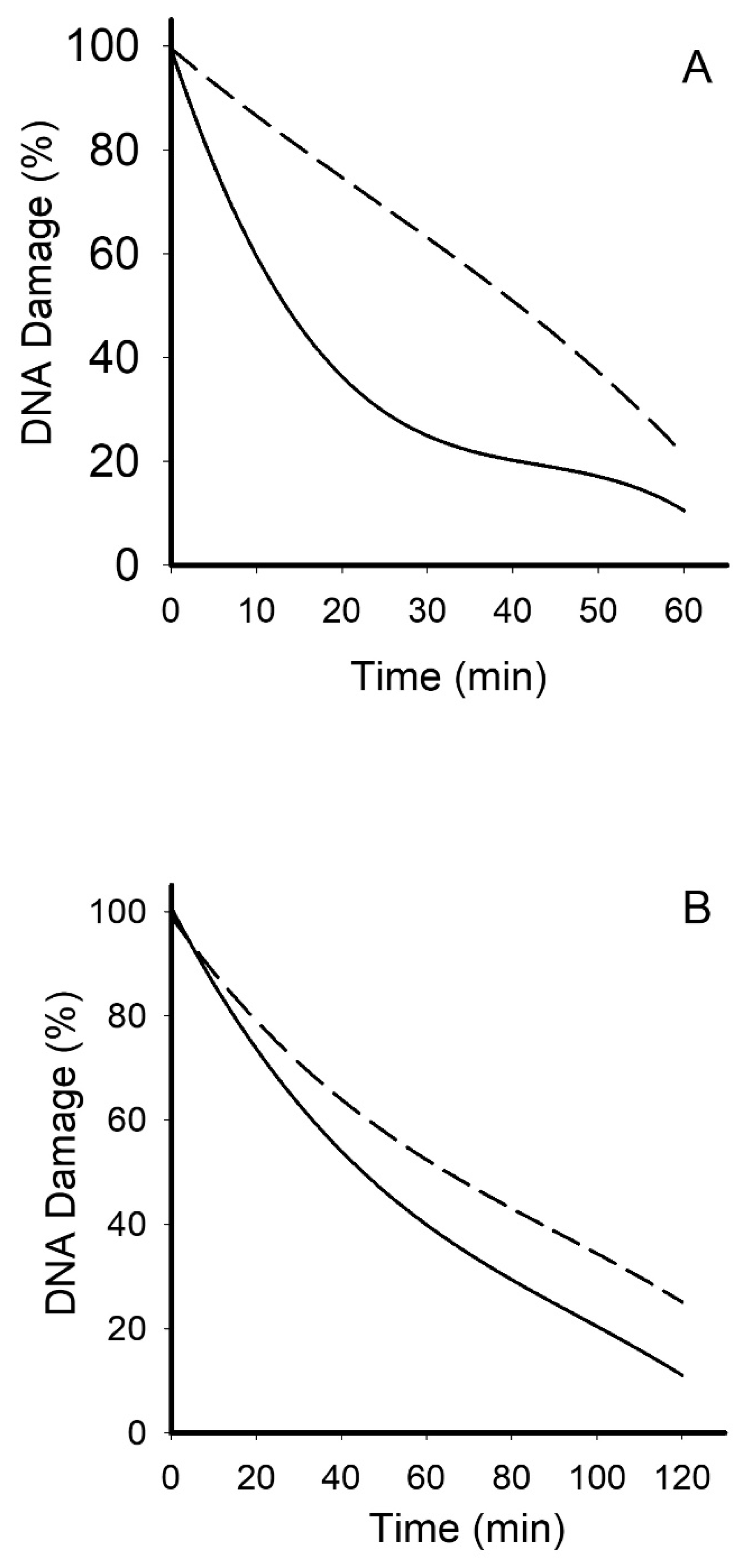Increased Sensitivity of PBMCs Isolated from Patients with Rheumatoid Arthritis to DNA Damaging Agents Is Connected with Inefficient DNA Repair
Abstract
1. Introduction
2. Experimental Section
3. Results
4. Discussion
5. Conclusions
Author Contributions
Funding
Conflicts of Interest
References
- Mercer, L.K.; Regierer, A.C.; Mariette, X.; Dixon, W.G.; Baecklund, E.; Hellgren, K.; Dreyer, L.; Hetland, M.L.; Cordtz, R.; Hyrich, K.; et al. Spectrum of lymphomas across different drug treatment groups in rheumatoid arthritis: A European registries collaborative project. Ann. Rheum. Dis. 2017, 76, 2025–2030. [Google Scholar] [CrossRef] [PubMed]
- Bhusate, L.L.; Herbert, K.E.; Scott, D.L.; Perrett, D. Increased DNA strand breaks in mononuclear cells from patients with rheumatoid arthritis. Ann. Rheum. Dis. 1992, 51, 8–12. [Google Scholar] [CrossRef] [PubMed]
- Karaman, A.; Binici, D.N.; Melikoğlu, M.A. Comet assay and analysis of micronucleus formation in patients with rheumatoid arthritis. Mutat. Res. 2011, 721, 1–5. [Google Scholar] [CrossRef] [PubMed]
- Li, Y.; Shen, Y.; Hohensinner, P.; Ju, J.; Wen, Z.; Goodman, S.B.; Zhang, H.; Goronzy, J.J.; Weyand, C.M. Deficient Activity of the Nuclease MRE11A Induces T Cell Aging and Promotes Arthritogenic Effector Functions in Patients with Rheumatoid Arthritis. Immunity 2016, 45, 903–916. [Google Scholar] [CrossRef] [PubMed]
- Maas, K.; Westfall, M.; Pietenpol, J.; Olsen, N.J.; Aune, T. Reduced p53 in peripheral blood mononuclear cells from patients with rheumatoid arthritis is associated with loss of radiation-induced apoptosis. Arthritis Rheum. 2005, 52, 1047–1057. [Google Scholar] [CrossRef] [PubMed]
- McCurdy, D.; Tai, L.Q.; Frias, S.; Wang, Z. Delayed repair of DNA damage by ionizing radiation in cells from patients with juvenile systemic lupus erythematosus and rheumatoid arthritis. Radiat. Res. 1997, 147, 48–54. [Google Scholar] [CrossRef] [PubMed]
- Majsterek, I.; Sliwinski, T.; Poplawski, T.; Pytel, D.; Kowalski, M.; Slupianek, A.; Skorski, T.; Blasiak, J. Imatinib mesylate (STI571) abrogates the resistance to doxorubicin in human K562 chronic myeloid leukemia cells by inhibition of BCR/ABL kinase-mediated DNA repair. Mutat. Res. 2006, 603, 74–82. [Google Scholar] [CrossRef] [PubMed]
- Wozniak, K.; Szaflik, J.P.; Zaras, M.; Sklodowska, A.; Janik-Papis, K.; Poplawski, T.R.; Blasiak, J.; Szaflik, J. DNA damage/repair and polymorphism of the hOGG1 gene in lymphocytes of AMD patients. J. Biomed. Biotechnol. 2009, 2009, 827562. [Google Scholar] [CrossRef] [PubMed]
- Bausinger, J.; Speit, G. DNA repair capacity of cultured human lymphocytes exposed to mutagens measured by the comet assay and array expression analysis. Mutagenesis 2015, 30, 811–820. [Google Scholar] [CrossRef] [PubMed][Green Version]
- Cooley, N.; Elder, R.H.; Povey, A.C. The effect of Msh2 knockdown on toxicity induced by tert-butyl-hydroperoxide, potassium bromate, and hydrogen peroxide in base excision repair proficient and deficient cells. BioMed Res. Int. 2013, 2013, 152909. [Google Scholar] [CrossRef] [PubMed]
- Perillo, B.; Di Donato, M.; Pezone, A.; Di Zazzo, E.; Giovannelli, P.; Galasso, G.; Castoria, G.; Migliaccio, A. ROS in cancer therapy: The bright side of the moon. Exp. Mol. Med. 2020, 52, 192–203. [Google Scholar] [CrossRef] [PubMed]
- Shao, L.; Fujii, H.; Colmegna, I.; Oishi, H.; Goronzy, J.J.; Weyand, C.M. Deficiency of the DNA repair enzyme ATM in rheumatoid arthritis. J. Exp. Med. 2009, 206, 1435–1449. [Google Scholar] [CrossRef] [PubMed]
- Brzezinska, O.; Macieja, A.; Lewandowska-Polak, A.; Sarnik, J.; Kubicka, M.; Makowska, J.; Popławski, T. AB0010 Evaluation of sensitivity to dna damaging agents and efficiency of dna repair in human peripheral blood mononuclear cellsfrom patients with dermatomyositis and polymyositis. Ann. Rheum. Dis. 2018, 77, 1209. [Google Scholar]



| Title 1 | RA patients n = 20 | Controls n = 20 |
|---|---|---|
| Sex | F 16; M 4 | F 16; M 4 |
| Age | 58.85 ± 15.15 | 63.5 ± 9.85 |
| Disease Duration | 10.15 ± 10.96 | |
| Remission | yes 5; no 15 | |
| CRP | 17.78 ± 23.80 | |
| ESR | 24.58 ± 15.85 | |
| RF | 202.16 ± 265.82 | |
| ACPA | 1934.12 ± 5577.19 | |
| Treatment | Methotrexate 10/20 Sulfasalazine 3/20 Glucocorticosteroids 7/20 |
© 2020 by the authors. Licensee MDPI, Basel, Switzerland. This article is an open access article distributed under the terms and conditions of the Creative Commons Attribution (CC BY) license (http://creativecommons.org/licenses/by/4.0/).
Share and Cite
Galita, G.; Brzezińska, O.; Gulbas, I.; Sarnik, J.; Poplawska, M.; Makowska, J.; Poplawski, T. Increased Sensitivity of PBMCs Isolated from Patients with Rheumatoid Arthritis to DNA Damaging Agents Is Connected with Inefficient DNA Repair. J. Clin. Med. 2020, 9, 988. https://doi.org/10.3390/jcm9040988
Galita G, Brzezińska O, Gulbas I, Sarnik J, Poplawska M, Makowska J, Poplawski T. Increased Sensitivity of PBMCs Isolated from Patients with Rheumatoid Arthritis to DNA Damaging Agents Is Connected with Inefficient DNA Repair. Journal of Clinical Medicine. 2020; 9(4):988. https://doi.org/10.3390/jcm9040988
Chicago/Turabian StyleGalita, Grzegorz, Olga Brzezińska, Izabela Gulbas, Joanna Sarnik, Marta Poplawska, Joanna Makowska, and Tomasz Poplawski. 2020. "Increased Sensitivity of PBMCs Isolated from Patients with Rheumatoid Arthritis to DNA Damaging Agents Is Connected with Inefficient DNA Repair" Journal of Clinical Medicine 9, no. 4: 988. https://doi.org/10.3390/jcm9040988
APA StyleGalita, G., Brzezińska, O., Gulbas, I., Sarnik, J., Poplawska, M., Makowska, J., & Poplawski, T. (2020). Increased Sensitivity of PBMCs Isolated from Patients with Rheumatoid Arthritis to DNA Damaging Agents Is Connected with Inefficient DNA Repair. Journal of Clinical Medicine, 9(4), 988. https://doi.org/10.3390/jcm9040988





